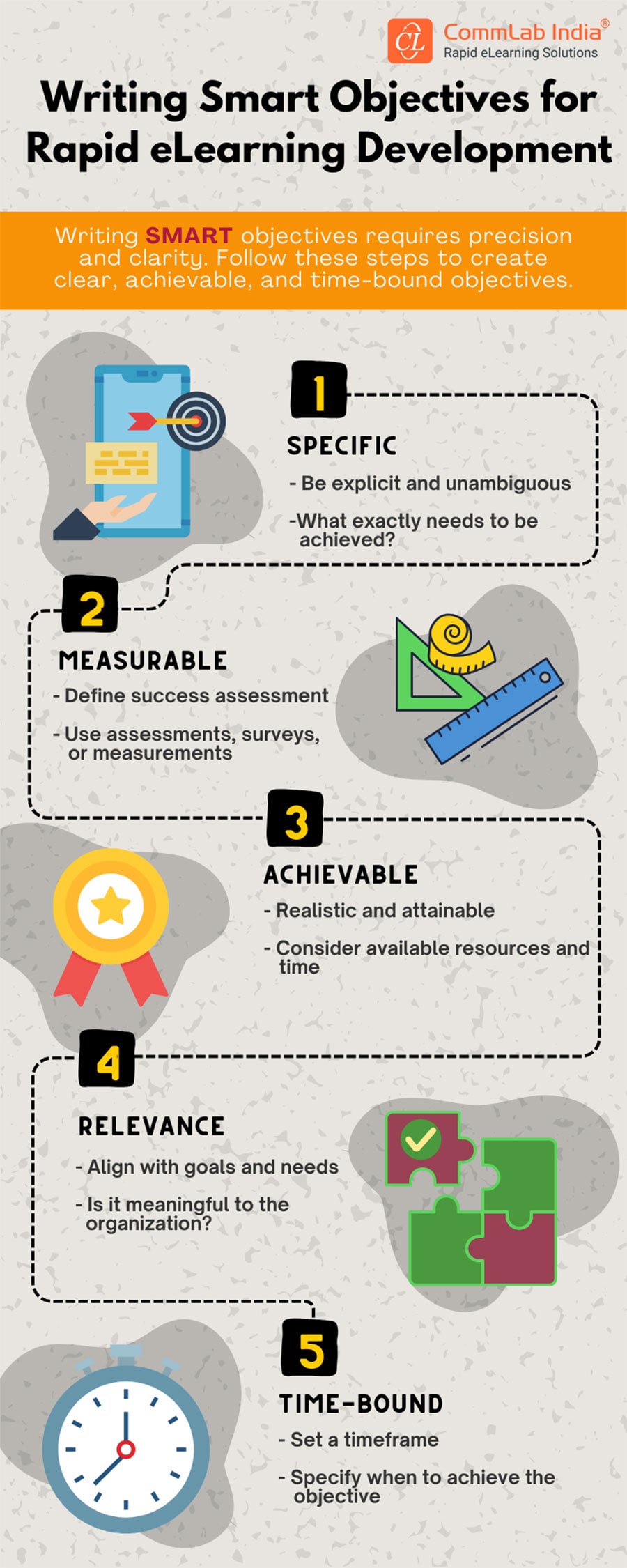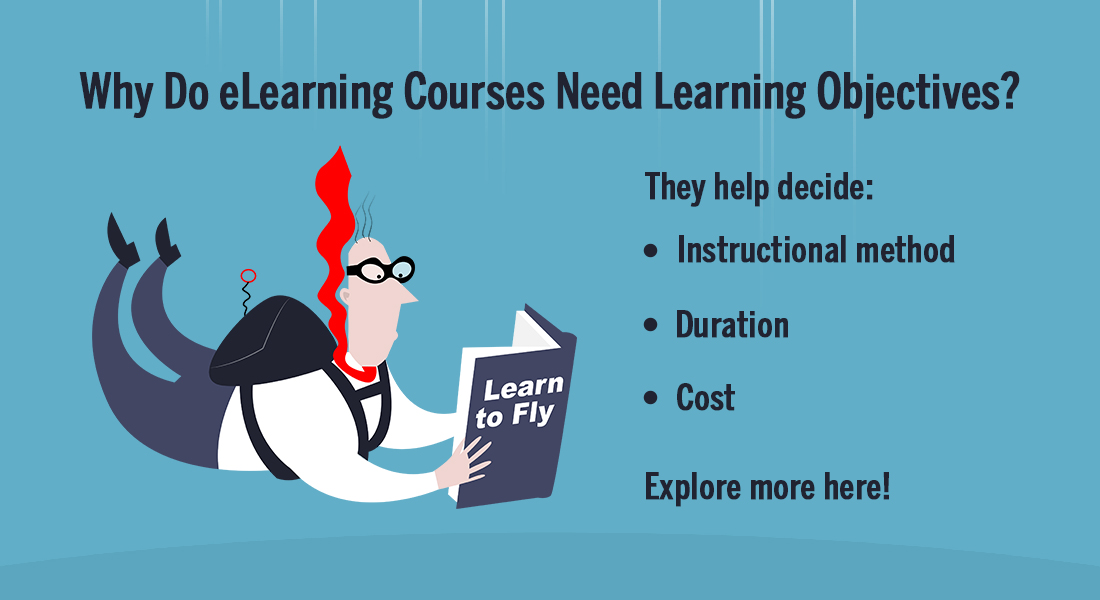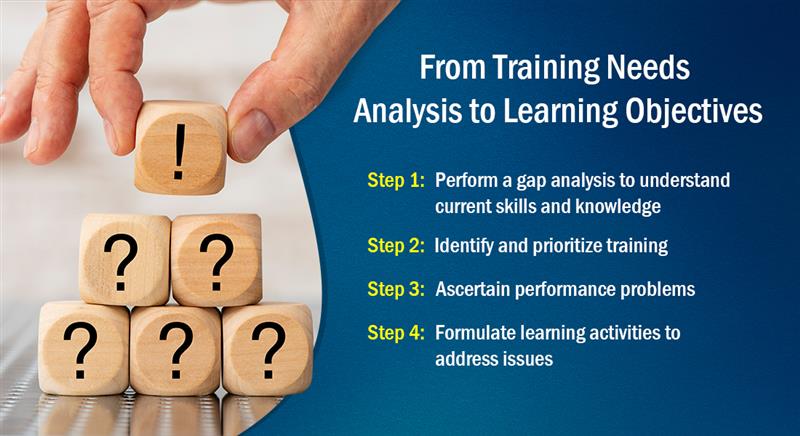A Blueprint for L&D Managers to Shape Business Succes with Learning Objectives
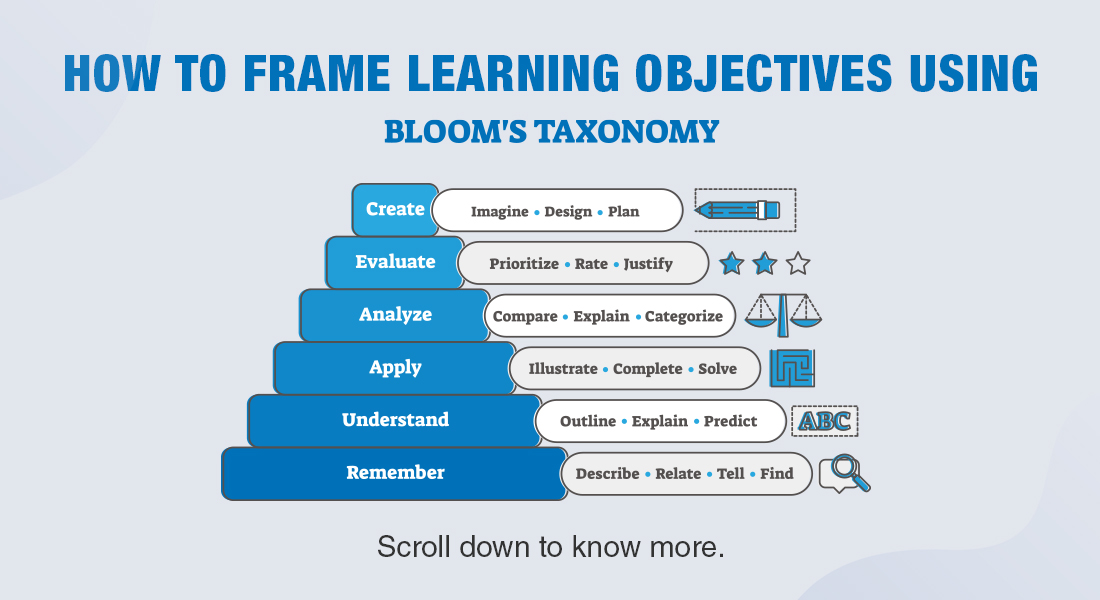
Imagine you're constructing a house. You wouldn’t start by just laying bricks and hoping everything fits together, right? You’d begin with a detailed blueprint that outlines each room, wall, and window. This blueprint ensures that every decision made during construction serves a clear purpose, and in the end, you have a sturdy, functional home. In the world of corporate training, learning objectives are like that blueprint.
The success of employee training and development hinges on one crucial element: well-defined learning objectives. These objectives are the cornerstone of effective corporate training programs, guiding every aspect of the learning journey—from content creation to evaluation.
→ Download Template: Questionnaire to Gather SME Inputs for Training and Save Time
Table of Contents
- Learning Objectives for Corporate Training Programs – Why?
- Learning Objectives for Corporate Training – How? Bloom’s Taxonomy
- How Bloom’s Taxonomy Enhances Learning Objectives in Corporate Training
- Two Steps L&D Managers Can Follow to Define the Right Learning Objectives
- The Next Step: From Learning Objectives to Practical Implementation
Learning Objectives for Corporate Training Programs – Why?
Learning objectives are SMART – Specific, Measurable, Achievable, Relevant, Time-bound – statements that specify what learners are expected to know, do, or feel after completing a corporate training program. They serve as a roadmap, ensuring training initiatives align with organizational goals and meet the needs of both employees and the business.
Whether upskilling your sales team, onboarding new hires, or rolling out compliance training, learning objectives bring clarity and focus. Here’s how they help –
1. Alignment with Business Goals
Learning objectives ensure that training initiatives are not just activities but strategic investments. By linking these objectives to key business outcomes, organizations can ensure their corporate training programs directly contribute to performance improvement and overall business success.
2. Enhanced Employee Engagement
Employees are more likely to engage with training when they understand its relevance to their roles and career growth. Clear objectives help learners see the "why" behind the training, motivating them to apply their newfound knowledge and skills in the workplace. This engagement is critical for sustaining interest and achieving long-term learning outcomes.
3. Streamlined Content Development
For instructional designers, learning objectives act as a blueprint for developing content. They help prioritize essential topics, eliminate unnecessary material, and create a logical flow that enhances the learning experience. This focus is especially crucial in today’s fast-paced corporate environments, where time is a premium.
4. Measurable Results
One of the most significant advantages of well-crafted learning objectives is the ability to measure training effectiveness. By setting clear, specific, and achievable goals, organizations can assess whether employees have gained the required knowledge or skills. This data is invaluable for refining future employee training and development initiatives.
6 Levels of Bloom’s Taxonomy to Frame Learning Objectives
- Remembering
- Understanding
- Applying
- Analyzing
- Evaluating
- Creating
Learning Objectives for Corporate Training – How? Bloom’s Taxonomy
How do you go about identifying and setting learning objectives for your custom eLearning courses? Ask any instructional designer about learning objectives(at your peril! They can talk your ears off on this topic), they will all, without exception, talk about Bloom’s Taxonomy.
What is Bloom’s taxonomy all about? And why is it so relevant for corporate training? When it comes to designing impactful corporate training programs, Bloom’s Taxonomy serves as a trusted framework for setting effective learning objectives.
Levels of Bloom’s Taxonomy
Developed by Benjamin Bloom in 1956, this hierarchical model categorizes cognitive skills into six levels, ranging from basic recall to complex evaluation and creation.
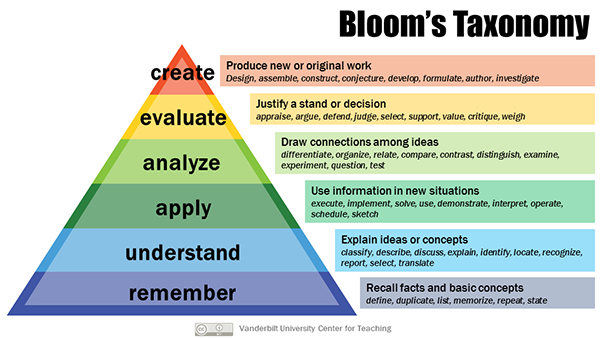
Source: Vanderbilt University Center for Teaching
For L&D managers, Bloom’s Taxonomy is an indispensable tool for ensuring structured, measurable, and learner-focused objectives that align with organizational goals.
Revised Bloom’s Taxonomy
The revised version of Bloom's Taxonomy, updated in 2001 by a team led by Lorin Anderson (a former student of Benjamin Bloom), replaced the original nouns used for each level with verbs (because learning is an active and continuous process) and also rearranged a few levels. The six levels remain hierarchical but now emphasize actions rather than static states levels.
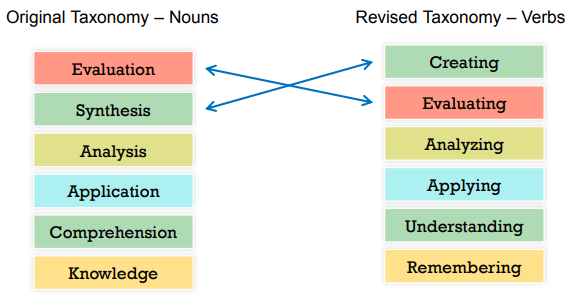
A Closer Look at Revised Bloom’s Taxonomy and Learning Objectives
1. Remembering
This is the basic level of learning that involves recalling or recognizing factual information. Common action verbs used for learning objectives for this learning level are list, outline, define, name, match, recall, identify, and label.
Example learning objectives:
- By the end of this course, learners will be able to list all steps to fill out a purchase order form in an ERP system.
- By the end of this course, learners will be able to name all parts of a robot vacuum cleaner.
You can use simple quiz assessments such as fill the blanks and multiple-choice questions for assessments at this level, as learners merely need to recall factual information.
2. Understanding
This is the second level where learning goes beyond memorizing factual information and focuses on the ‘how’ and ‘why’ of things. At this level, learners need to be able to understand the meaning of the information provided and interpret it for their use.
Common action verbs used in learning objectives for this level are describe, explain, paraphrase, give original examples of, summarize, contrast, interpret, discuss.
Example learning objectives:
- By the end of this course, learners will be able to describe different ways that a purchase order form can be rendered invalid.
- By the end of this course, learners will be able to explain how the vacuum cleaner works.
Assessments in eLearning courses you can use for this level include drag and drop, match the columns, arrange in sequence, etc., to assess learners’ understanding.
3. Applying
The third level of Bloom’s taxonomy focuses on translating knowledge into action. Learning objectives at this level should enable learners to apply the information they have learned to perform a task or activity at hand.
The corresponding action verbs for learning objectives for this learning level are calculate, apply, solve, show, illustrate, use, demonstrate, determine, and perform.
Example learning objectives:
- Demonstrate how to generate a purchase order using the given information.
- Show howto clean out the robot vacuum cleaner after use.
For the first learning objective, you can use Watch-Try-Do simulations to assess if learners can generate a purchase order on their own at the end of the course.
4. Analyzing
This level of Bloom’s taxonomy focuses on the analytical and comparative aspects of learning. Learning objectives at this level should enable learners to think critically, analyze a given situation, and apply that knowledge to perform a task.
Action verbs used for learning objectives at this level are classify, break down, categorize, analyze, criticize, simplify, compare.
Example learning objectives:
- Compare the sales process followed in the US vs. the UK.
- Analyze the malfunctioning vacuum cleaner to identify the problem.
- Classify different forms generated in the ERP system into orders, purchase orders, and payroll.
Scenarios, especially branching scenarios, can be a useful instructional strategy for this level of learning. Also, since achieving this level of learning can be complex and may need an instructor’s guidance, you can employee blended learning and collaborative learning approaches for this.
5. Evaluating
At this level of Bloom’s taxonomy, learning objectives enable learners to assess the information given and take decisions or act based on their assessment. Action verbs used for these learning objectives include choose, support, defend, judge, grade, argue, justify, support, convince, select, evaluate, assess, rank.
Example learning objectives:
- Assess the impact that creating a purchase order has on the organization’s Procure-to-Pay process.
- Convince a customer why your vacuum cleaner is better than a competitor’s product.
- Justify the high cost of the robot vacuum cleaner.
This level of learning is best handled through a blended learning approach but can be done through a custom eLearning course as well.
6. Creating
This is the highest level of learning where learners should be able to build on their existing knowledge and create a new idea or product. Action verbs for learning objectives at this level include design, formulate, build, invent, create, compose, generate, derive, modify, and develop.
Example learning objectives:
- Modify the current vacuum cleaner model to make it more energy efficient.
- Formulate a new sales plan to increase revenue.
- Create a new mobile app using the C++ programming language.
Key Changes in the Revised Taxonomy
- Renaming Levels: Level names were changed from nouns to verbs to emphasize the active nature of thinking and learning. For example, "Synthesis" became "Creating."
- Reordering Levels: The highest level in the original taxonomy, "Evaluation," was moved below "Creating," making "Creating" the pinnacle of cognitive processes.
- Broadening the Focus: The revised taxonomy includes metacognitive dimensions, encouraging a deeper understanding of how learners think and learn.
Why the Revised Taxonomy Matters in Corporate Training
For corporate training and employee development, the revised taxonomy is invaluable because it:
- Aligns with modern instructional design principles that emphasize active, applied learning.
- Encourages the creation of more dynamic and practical learning objectives.
- Supports skill progression from foundational knowledge to innovation and creativity, which are critical for roles in fast-evolving industries.
How Bloom’s Taxonomy Enhances Learning Objectives in Corporate Training
1. Offer Clarity and Focus
Bloom’s Taxonomy helps L&D professionals write precise learning objectives tailored to the cognitive level needed for specific roles. For example, compliance training may focus on "Remembering" and "Understanding," while leadership development programs may target "Analyzing" and "Evaluating."
2. Customize based on Employee Roles
Different roles demand varying skill levels. Using Bloom’s Taxonomy, L&D managers can design learning objectives that cater to the specific cognitive demands of entry-level employees versus experienced team and managers.
For instance:
- Entry-level sales rep: Identify the key features of our product.
- Senior sales rep: Compare the functionality of our product with that of our closest competition
3. Facilitate Assessments
Bloom’s Taxonomy ensures that learning objectives are measurable. For instance, if the goal is to "Apply conflict resolution techniques in team settings," assessments can be designed as role-play exercises or case studies to evaluate application skills.
Explore the Inseparable Trio: Learning Objectives, Training Content, Assessments
Two Steps L&D Managers Can Follow to Define the Right Learning Objectives
Setting clear learning objectives is crucial for developing effective corporate training programs that align with business goals and improve employee performance. To ensure these objectives are relevant and actionable, L&D managers can follow a structured two-step approach.

1. Identify Performance Gaps
A performance gap is the difference between an employee's current performance and the desired performance – which will help meet business KPIs. Understanding these gaps is the first step in determining what the training program should aim to achieve.
Conduct a Needs Analysis
Begin by assessing current performance levels within your team. This can involve analyzing key performance indicators (KPIs), reviewing employee performance appraisals, or gathering feedback from supervisors and team leaders. The goal is to identify specific areas where performance falls short of expectations.
Use Employee Feedback
Employees have a first-hand understanding of the challenges they face in their roles. Use surveys, focus groups, or interviews to gather their input on where they feel unsupported or underprepared. This information can provide insights into underlying causes of performance issues.
Analyze Business Goals
Align performance gaps with broader organizational objectives. For example, if the company aims to increase customer retention, a performance gap might lie in the sales team’s ability to handle objections or build rapport with clients.
Tools to Identify Gaps
L&D managers can leverage tools such as training needs analysis templates, 360-degree feedback systems, and employee observation checklists to systematically identify performance gaps.
By pinpointing performance gaps, L&D managers can ensure the training program addresses real challenges that impact both employees and the organization.
2. Identify Skills and Knowledge Required to Fill Performance Gaps
Once performance gaps are identified, the next step is to determine the specific skills, knowledge, or behaviors employees need to bridge these gaps. This step connects training objectives directly to job requirements and business outcomes.
Consult Subject Matter Experts (SMEs)
SMEs can provide valuable insights into the competencies required to perform specific tasks effectively. They can also help clarify what knowledge employees need and how it should be applied in their roles.
Map Skills to Performance Gaps
Break down each performance gap into the skills or knowledge areas that are lacking. For instance, if the gap is:
- Poor customer service, the required skills might include communication, active listening, and problem-solving
- Low productivity, the required skills could involve time management, task prioritization, or using specific software tools
Categorize Learning Needs
Separate the required skills and knowledge into categories such as:
- Technical Skills: Proficiency with tools, systems, or software
- Soft Skills: Interpersonal abilities such as leadership, teamwork, or negotiation
- Knowledge: Understanding policies, procedures, or industry regulations
Prioritize Learning Needs
Not all performance gaps may need to be addressed immediately. Prioritize learning needs based on their impact on performance and alignment with organizational goals.
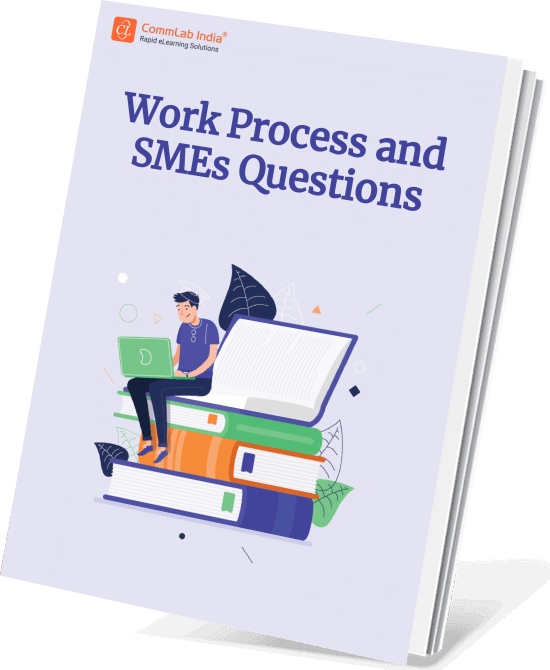
Gather SME Inputs for Training
Editable Questionnaire to Save Time and Streamline the Process!
- Holistic questions to identify training needs
- Flexibility to share content inputs
- Easy to share, fill, save, access
- Eliminate gaps, misses, duplications
3. Connecting Performance Gaps to Learning Objectives
After completing these two steps, L&D managers can craft targeted learning objectives that directly address identified gaps and skills requirements.
Example 1
Performance Gap: Employees struggle to convert leads into sales.
Required Skills: Sales negotiation, objection handling, and product knowledge.
Learning Objective: "Demonstrate the ability to handle common objections during sales calls to increase conversion rates by 10%."
Example 2
Performance Gap: Low compliance with data privacy policies.
Required Knowledge: Understanding of GDPR regulations and secure data-handling practices.
Learning Objective: "Apply GDPR guidelines to accurately classify and secure customer data during daily operations."
By identifying performance gaps and the corresponding skills or knowledge, L&D managers can ensure learning objectives are both actionable and aligned with the desired outcomes of the training program.
4. Why This Approach Works
- Relevance: By starting with performance gaps, training programs are grounded in real-world issues, ensuring relevance to both employees and organizational needs.
- Focus: Identifying specific skills and knowledge narrows the scope of the training, making it more focused and effective.
- Measurability: This approach ensures that learning objectives are measurable, enabling L&D managers to track progress and evaluate the impact of the training program.
- Alignment: Training objectives developed this way naturally align with business goals, maximizing ROI for the organization.
5. Guiding Questions for Identifying Learning Objectives
Here are a few guiding questions for each step L&D managers can use to identify performance gaps and the skills/knowledge required to fill them.
Step 1: Identify Performance Gaps
The goal is to understand where employees are falling short and why.
- What are the key responsibilities of the target role(s)?
- Which tasks or responsibilities are not being performed to the desired standard?
- What specific outcomes or behaviors would define success in this role?
- What challenges or barriers might be contributing to these performance issues?
- Are these challenges related to skill, knowledge, motivation, tools, or external factors?
- What feedback have employees received from supervisors, peers, or clients about their performance?
- How do these performance gaps affect team productivity, customer satisfaction, or other organizational goals?
- What would be the impact if these gaps were resolved?
- Has training been conducted previously to address this issue? If yes, what was the outcome?
- Do employees have access to the tools and resources necessary to perform their tasks?
- What metrics or performance data indicate that there is a gap? Are these metrics specific enough to guide training efforts?
Step 2: Identify Skills and Knowledge Required to Fill Performance Gaps
The goal is to determine what employees need to learn or improve to bridge the identified gaps.
- What skills are critical for this role but currently lacking?
- What existing information and resources do employees need to perform their tasks effectively?
- How do employees prefer to learn new skills (e.g., on-the-job training, eLearning, workshops)?
- How will employees apply this new skill or knowledge in their daily roles?
- What are the most important tasks employees need to complete after the training?
- Are there specific competencies tied to these tasks?
- How will acquiring this skill or knowledge help employees meet performance targets?
- What measurable improvements are expected post-training?
- Which skills or knowledge areas are the most urgent to address?
- Are there secondary skills that could be trained later?
- What metrics or behaviors will indicate that employees have acquired the required skills?
The Next Step: From Learning Objectives to Practical Implementation
Defining clear learning objectives is a critical first step in creating impactful corporate training programs. However, the process doesn’t stop there. After defining the objectives, L&D managers need to gather accurate content from subject matter experts (SMEs). SMEs bring invaluable insights to job-specific skills, knowledge gaps, and practical applications that help align learning objectives with real-world requirements.
Engaging with SMEs is where theory meets practicality. These conversations ensure training content not only meets organizational goals but also resonates with the learners. Yet, many L&D managers find it challenging to extract the right information during SME interviews. Common hurdles include unclear expectations, inconsistent communication, or a lack of structured questions to guide the discussion.
Simplifying the SME Collaboration Process
To help you overcome these challenges, we’ve developed a comprehensive SME Interview Template and Questionnaire. This tool is designed to simplify the process of gathering insights, ensuring the information you collect is both relevant and actionable. With this template, you can:
- Define Scope: Clarify what aspects of the training program you need expertise on, ensuring focused discussions.
- Structure Questions: Use pre-built, targeted questions that address key areas such as job roles, skill gaps, common challenges, and desired outcomes.
- Streamline Documentation: Record responses in an organized format, making it easier to reference later during content creation.
If you’re ready to take your learning objectives from concept to implementation, download our SME Interview Template. This tool will empower you to transform high-level training goals into actionable, learner-focused content that drives measurable results.


